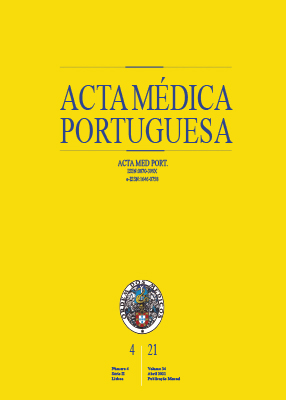Placenta Accreta Overlying a Caesarean Section Scar: A 10-Year Experience in a Tertiary-Care Centre in Portugal
DOI:
https://doi.org/10.20344/amp.14001Keywords:
Placenta Diseases, Placenta Accreta, PortugalAbstract
Introduction: Placenta accreta spectrum disorders are among the leading causes of maternal morbidity and mortality and their prevalence is likely to increase in the future. The risk of placenta accreta spectrum disorders is highest in cases of placenta previa overlying a previous cesarean section scar. Few studies have evaluated placenta accreta spectrum disorders in Portugal. The aim of this study was to review the cases of placenta accreta spectrum overlying a cesarean section scar managed in a Portuguese tertiary center over the last decade.
Material and Methods: Retrospective, cross-sectional study, with data collected from hospital databases. Only cases with histopathological confirmation of placenta accreta spectrum were included.
Results: During the study period, 15 cases of placenta accreta spectrum overlying a cesarean section scar were diagnosed (prevalence 0.6/1000). All cases were diagnosed antenatally. A transverse cesarean section was present in all cases; 13 were managed by a scheduled multidisciplinary approach, while two required emergent management. Total or subtotal hysterectomy was performed in 12 cases. There were no cases of maternal or neonatal death. Histopathological evaluation confirmed nine cases of placenta accreta, three cases of placenta increta and three cases of placenta percreta.
Discussion: Early antenatal diagnosis is important for a programmed multidisciplinary management of these cases, which may reduce potential morbidity and mortality and ensure better obstetric outcomes.
Conclusion: This case series of placenta accreta spectrum overlying a cesarean section scar reports the reality of a tertiary-care perinatal center in Portugal, in which no maternal or neonatal mortality due to placenta accreta spectrum was registered over the last decade; this may be attributed to prenatal diagnosis and a coordinated multidisciplinary team approach.
Downloads
Downloads
Published
How to Cite
Issue
Section
License
All the articles published in the AMP are open access and comply with the requirements of funding agencies or academic institutions. The AMP is governed by the terms of the Creative Commons ‘Attribution – Non-Commercial Use - (CC-BY-NC)’ license, regarding the use by third parties.
It is the author’s responsibility to obtain approval for the reproduction of figures, tables, etc. from other publications.
Upon acceptance of an article for publication, the authors will be asked to complete the ICMJE “Copyright Liability and Copyright Sharing Statement “(http://www.actamedicaportuguesa.com/info/AMP-NormasPublicacao.pdf) and the “Declaration of Potential Conflicts of Interest” (http:// www.icmje.org/conflicts-of-interest). An e-mail will be sent to the corresponding author to acknowledge receipt of the manuscript.
After publication, the authors are authorised to make their articles available in repositories of their institutions of origin, as long as they always mention where they were published and according to the Creative Commons license.









